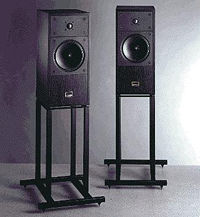There have been a plethora of compact hi-fi loudspeakers on the market since the original Goodmans Maxim of the 1960s, but very few miniature ones. How many professional hi-fi firms do you know that have created significant speakers that fit in the palm of your hand?
Of course, if there was ever a country that would be capable of producing such a device, it would be Japan. Space is at a premium in this packed country, which has double the population in a similar landmass. Sound is also at a premium, thanks to high disposable incomes and an insatiable need for high-quality music. When you combine the two, you have a huge market for ‘mini-compo’ systems, some of which may provide excellent sound.
The Aurex microsystem and the Technics SL-10 – the former a suite of expensive miniature electronics with sound that battered similarly priced full-size separates, the latter an epoch-making fully automatic quartz locked direct drive linear tracking turntable, complete with its own moving coil cartridge and head amp(! ), that at 300mm square was barely larger than the s – kicked off the whole tiny hi-fi thing in earnest in Japan in the late 1970s.
The Aurex technology spawned a slew of knockoffs from companies including Aiwa (the microsystem) and Mitsubishi (the M-04). The Technics sparked a whole series of small parallel trackers from a number of manufacturers, all of which used the same fundamental architecture but were never made as well as the Technics — not to mention the SL-15, SL-7, and SL-5 variants of the SL-10. But what about loudspeakers to accompany these minuscule wonders? Well, not many people are aware of this, but…
Technics introduced a line of smaller loudspeakers in 1979, the smallest of which (the 180x150x150mm SB-F1) was an ideal match for the SL-10 turntable. It not only looked the same, but it also had the same superb (some might say astounding) build quality, excellent sonics, and a fairly hefty price tag. It was almost as expensive as Linn’s high-end LP12 turntable (which retailed for £256) at £220 per pair. The £300 SB-F2 (200x150x180mm) and £360 SB-F3 (230x170x170mm).
The SB-most F1’s remarkable feature is its diminutive size: it makes a Linn Kan look like a KEF 105. The sleek styling, which looks as new in 2005 as it did twenty-five years ago, is the next thing you notice. Then, as you pick it up and hold the base in your palm, you notice that it’s different — it’s cold and heavy, just like the British winter. Yes, the SB-F1 is constructed entirely of cast aluminium alloy.
The speaker is made of a creative clamshell design. A single central bolt with a Philips screw head pulls the front and back parts together under tension. Unscrew this, and the SB-F1 disassembles, revealing the cabinet walls to be extremely thick (thus the weight) and sturdy. A tiny 100mm paper woofer and a 25mm paper cone tweeter are both attached solidly to the inside of the front clamshell, linked to a somewhat sophisticated crossover with high-quality passive components. The usage of lightweight paper drivers (as Audionote AN-E users are aware) results in an incredibly high 86dB/m sensitivity figure, which is incredible for a sealed, infinite baffle design with almost no air inside the cabinet! Of course, high-power transistor amplifiers are all that is required… There’s a crossover protection circuit reset button on the back of the speakers for when the inevitable happens, proving that these babies were built for professional (near field monitoring) use as well.
The sound quality is excellent, especially considering the size of the room. Believe me, you won’t be put off by their physical presence, but they’re a surprisingly forceful listen and musically expressive like few others. You may think of them as a Japanese version of Linn Kan I. They make music bounce like few others because they are brilliantly fast and entertaining. However, don’t anticipate a flawlessly sleek and smooth sound; they aren’t the pinnacle of refinement — the AR18S is a decent benchmark…
You won’t find many of these these days; they weren’t exactly a runaway sales success, but they’re definitely worth looking into as a backup system; price is what you pay for them. A mint-condition pair should fetch several hundred pounds, but dog-eared copies will likely fetch a tenth of that. Still, get a good pair and you’ll be a true believer in the phrase “less is more.”







